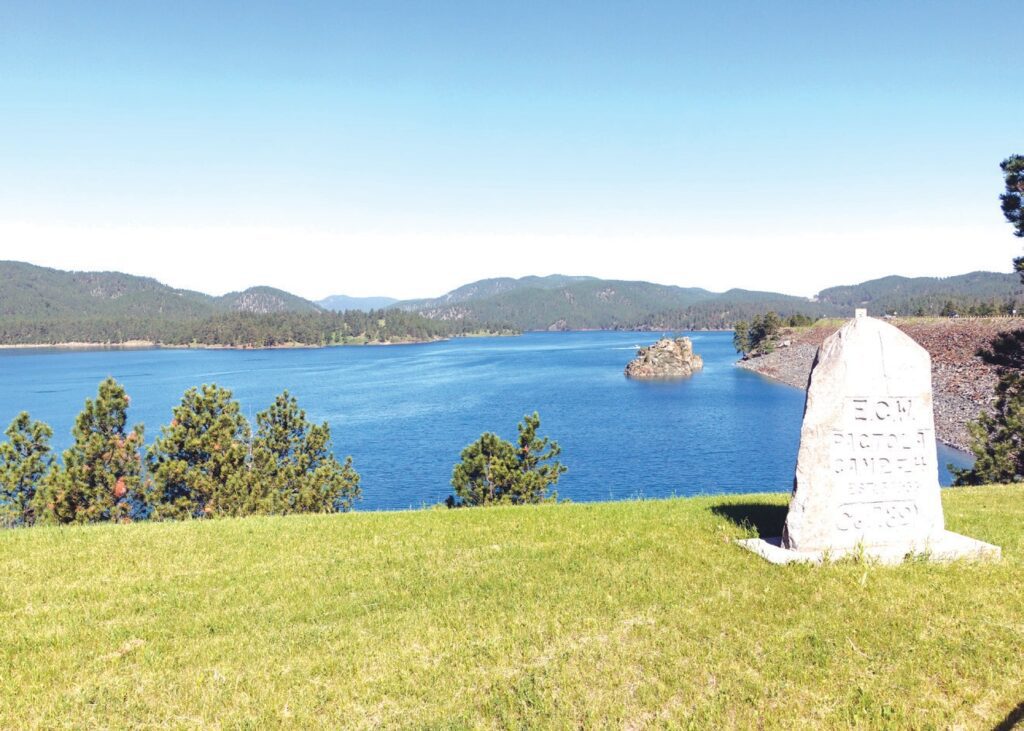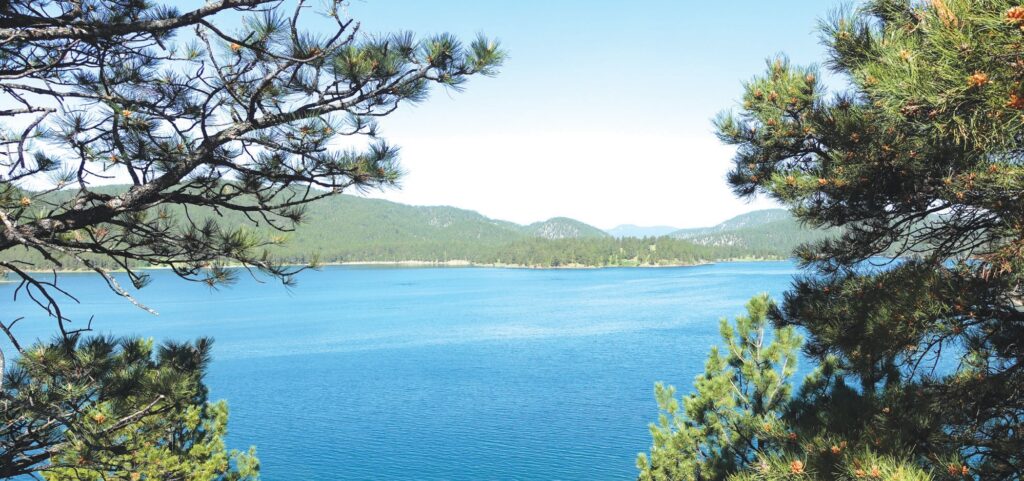Water protection was made possible by diverse grass roots efforts
RAPID CITY – Outgoing Secretary of the Interior Deb Haaland called the Pactola Reservoir-Rapid Creek Watershed a “treasured landscape” as she finalized her decision to withdraw more than twenty thousand acres in the Black Hills National Forest from drilling and mining for 20 years. Non-federal lands and minerals are not subject to the withdrawal.
It’s unclear what is ahead for these protection efforts as the incoming advisors to president-elect Donald Trump are recommending he waive environmental reviews to boost mining of rare earth elements according to reporting from Reuters. Lilias Jarding said the Black Hills Clean water Alliance will have to be ready to respond in real time if there are any proposals.
“What’s really important for people to understand is that individuals can have an impact on what’s happening in the Black Hills because nineteen-hundred individuals commented in favor of the withdrawal and that made it possible for the withdrawal to move ahead.”

View of Pactola Lake from the Visitors Center. In the foreground, a marker dated 5/18/33 for the long-defunct Pactola Camp F-4, a Civilian Conservation Corps federal relief program. (Photo by Marnie Cook)
The area is considered a sacred landscape and traditional spiritual homeland by the Oceti Sakowin but also many neighboring tribes: Cheyenne, Arapahoe, Arikara, Hidatsa, Mandan, and Crow Tribes. There are places within the Black Hills that are sacred to all these tribes, including the lands of the withdrawn area.
“The Black Hills hold the Lakota creation stories, our coming into being as human beings,” said Grandmother Earth Advocate Carla Rae Marshall (Cheyenne River Sioux Tribe/Mnicoujou/ Oglala Lakota). “They hold our traditional teachings; they hold space for our spiritual ceremonies and provide for our natural foods and plant medicines.”
This protection represents just ten percent of the watershed, but Marshall explained its importance. “It may seem small but it’s rewarding to know that protecting this ten percent will cover the Big Horn Sheep birthing range in that area along with the thousands of other wildlife and plant species. They depend on clean, natural flowing water so we humans have to advocate for their safety. This withdrawal of 20,510 acres will be a small sanctuary for wildlife for 20 years, as long as it doesn’t get kicked back out.”
“It all started with F3 Gold’s exploration project in Jenny Gulch, called the Jenny Gulch Exploration Drilling Project,” said Marshall. The mineral exploration company based in Minnesota proposed the project above Jenny Gulch, an arm of the Pactola Reservoir, which is the water supply for Rapid City, Ellsworth Air Force Base, as well as reservations and rural communities along the Cheyenne River.
Marshall said that they have been working to get this Order for four years and during that time have built support across a diverse group of people – tribes, recreationists, and local ranchers – because of the impact on sensitive cultural areas, outdoor recreation and tourism and grazing for ranchers.
Backcountry Hunters and Anglers (BHA) said the decision was a victory and commended the Department of Interior and the U.S. National Forest Service for the final decision. “We fully support the Biden Administration’s decision to protect the Pactola-Rapid Creek Watershed from the threats posed by mining and other disruptive developments,” said Cody Grewing, Chair of the South Dakota Chapter of the BHA. “This place holds immense value for hunters, anglers, and outdoor enthusiasts alike. It’s also home to vital habitat for a wide range of species and provides clean drinking water to thousands of South Dakotans.”
Grewing also said that outdoor recreation is a mainstay for the South Dakota economy bringing in millions of dollars and thousands of jobs. “It’s critical wintering ground and habitat for deer and elk.” He said that it wouldn’t be wise to risk the quality habitat and clean water for momentary gain.
Marshall said that there has been a growing grass roots movement which has included a large number of people commenting over the years, including this last period when hundreds of people took the opportunity to comment during the allotted period, which was extended.
Marshall said the support of the people has been crucial. “They understand the importance of protecting the water and protecting the land regardless of whether they are Native or not. They see the value of the land and the water as opposed to one company coming in here and trying to make a profit.”
Their continued monitoring was crucial. “We were keeping track of F3’s actions and then the Forest Service gave them a FONSI,” said Marshall referring to the Finding of No Significant Impact. “Then we tackled that FONSI and said no, there will be significant impact if you allow this project to move ahead. This is an important watershed. Pactola is an important reservoir. It has implications of national security.”
Marshall mentioned that many settler descendants, who now feel connected to the Black Hills, have shown support. For example, William Young publicly stated that he not only supports the withdrawal but also wants the entire Rapid Creek Watershed to be protected. “I am a life-long resident of the Black Hills, and my family has owned property on Rapid Creek for more than 60 years. In fact, my great grandparents homesteaded in western SD in the late 1880’s. Suffice to say I have a vested interest in keeping our environment healthy and clean water is paramount. I, along with many concerned residents, engage in monthly creek cleanups throughout Rapid City. We also use our creek for recreation as well as clean drinking water. Virtually EVERY mine that has been permitted in the Black Hills has had some type of toxic spill, including two superfund sites. The Black Hills does not need more mining. “
Lilias Jarding from the Black Hills Clean Water Alliance said previous withdrawals were meant to address public recreation and so would protect the area right around the shore of Sheridan Lake or around the shore at Pactola. “This withdrawal goes beyond that and covers what used to be an active gold drilling area. So, while it doesn’t solve the whole problem for us it sets a precedent in the Black Hills and it’s something that we can build on.”
Jarding said the Black Hills is not a big area, “if you’re talking about the ecology and cultural resources. If you destroy some of them with mining then you destroy a lot of the Black Hills.”
“We will continue to watch these mining projects and their efforts to disturb our lands and the potential to contaminate water,” said Marshall. “We need to keep in mind that the 25,510-acre withdrawal is not nearly enough to protect the Rapid City Watershed because upstream from this area there are mining claims. We all know that what affects us upstream will affect us downstream. Water here in the Black Hills goes in all directions so it’s of concern that the entire nearly 200-thousand acres of the Rapid City Watershed is not included since there are those existing mining claims both upstream and downstream.
(Contact Marnie Cook at cookm8715@gmail.com)
The post Water protection was made possible by diverse grass roots efforts first appeared on Native Sun News Today.
Tags: Top News

